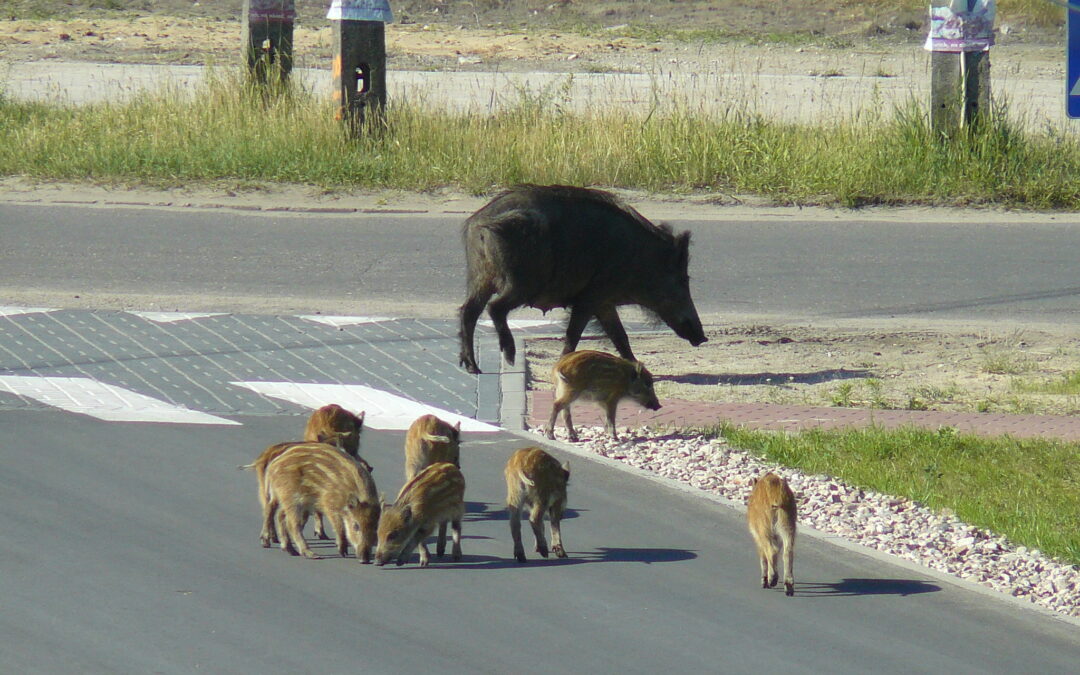Authorities in Warsaw are warning residents that they are increasingly likely to bump into wild boars on the streets. Polish cities have been reporting ever higher numbers of the animal in recent years.
The issue in the capital has been highlighted by city councillor Anna Auksel-Sekutowicz, who alerted Warsaw’s safety and public order committee after a recent encounter with a family of boars with 12 young in the Białołęka district.
“Wild boars out for walks can be seen increasingly often in Białołęka,” said Auksel-Sekutowicz. “And more and more often residents are informing about these meetings near to their homes. This is worrying and dangerous.”
Auksel-Sekutowicz added that Magdalena Młochowska, the city official responsible for Warsaw’s green spaces, confirmed that her office was receiving increasing numbers of notifications of boar sightings in Białołęka as well as in Wawer and Wilanów. Młochowska asked residents to report any encounters, as the city authorities always intervene.
Wild boars have been increasingly frequent visitors to the streets of Polish cities in recent years, and the population in the capital has been rising, Andżelika Gackowska of Warsaw City Forests told the Polish Press Agency (PAP).
“It’s not that the boars come to the city because we’re chopping down forests,” Gackowska explained. “These animals have often never seen a forest. They simply live in the city. They sleep in the undergrowth and green spaces, and get food near households.”
Wild boars are very intelligent and capable of remembering the times when they are likely to have food shared with them by children leaving school or an elderly lady frequenting the park, she added. “They can even remember the bio waste collection timetable and come in the evening or morning to check whether residents have left bags out.”
This, along with a lack of natural enemies, has led to a growth in Warsaw’s boar population, Gackowska noted. “One sow can give birth to even 10 young and they all survive. In the autumn they start to look almost like adults. If three or four sows form a sounder, we have a group of several dozen.”
“Animals are increasingly bold in entering areas they were not seen in before: housing estates, playgrounds, city parks,” Marlena Salwowska of Warsaw city hall told Rzeczpospolita last year. “They also move freely between the capital and neighbouring municipalities.”
Cases of African Swine Fever (ASF) in recent years have complicated dealing with urban wild boars, which cannot be moved away because of the potential spread of the disease.
On the other hand, the lack of new ASF cases as well as the safety of human residents rule out a cull, which would require the approval of the city’s mayor.
The only option the Warsaw authorities are left with is to scare wild boars from the most frequented areas or to chase them into one of the municipal forests.
Despite major culls in recent years, the wild boar population in Poland has increased dramatically this century. According to government statistics, there were 81,000 in 1995 and 215,000 in 2017.
In 2019, however, then agriculture minister Jan Krzysztof Ardanowski admitted that the true figure is unclear, with estimates varying between 200,000 and 1 million.
“The factors that used to limit the boar population – lower availability of food and harsh winters – no longer apply as they once did,” explained Rafał Kowalczyk, director of the Mammal Research Institute of the Polish Academy of Sciences at the time. “We have milder winters…increasing their survivability…and secondly, the animals’ food supply is increasing.”
Main image credit: Wikimedia/Filip Dabrowski (under CC BY-SA 3.0)

Ben Koschalka is a translator and senior editor at Notes from Poland. Originally from Britain, he has lived in Kraków since 2005.



















